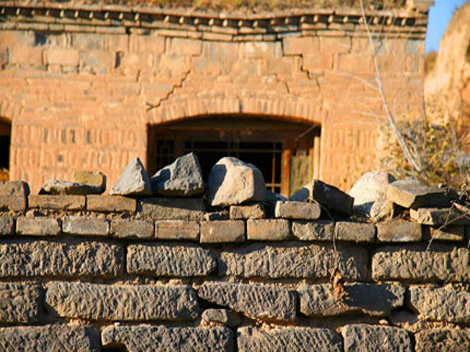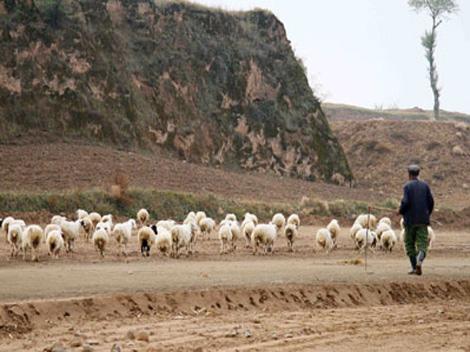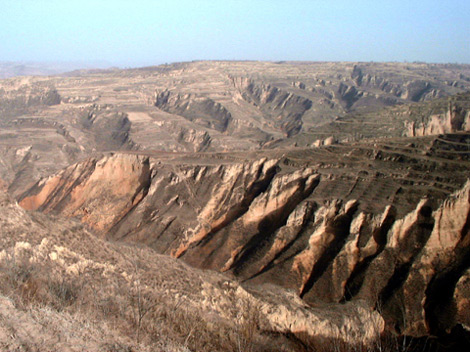more>>More News
- National Day
- ways to integrate into Chinese style life
- Should they be in the same university with me?!!
- Chinese Ping Pang Legend: the Sun Will Never Set
- A Glance of those Funny University Associations
- mahjong----The game of a brand new sexy
- Magpie Festival
- Park Shares Zongzi for Dragon Boat Festival
- Yue Fei —— Great Hero
- Mei Lanfang——Master of Peking Opera
Miracles on
By admin on 2015-01-16
Shanxi ,China's largest coal producer ,is in a land of high stark plateaus and little greenery." Dismal, dusty and forbidding. "That's what most people think of .

Centuries of deforestration, overgrazing and unregulated development have stripped the land of vegetation, eroded the soil and allowed the desert to encroach on the Loess Plateau in north central China.
But my preconception was changed dramatically by a visit to remote Youyu County where people have been reclaiming land for 60 years, planting trees and turning the land green and gold.
I witnessed a miracle.
Youyu is in the northwestern tip of Shanxi bordering the Inner Mongolia Autonomous Region. It's sandy, windy and accessible only by road.
It is listed as one of China's most impoverished places, and in the 1950s the United Nations called it uninhabitable and suggested the entire population be relocated to more hospitable land.
It's still poor today. Population 100,000. Goats 600,000.
But it is attracting photographers and adventurers in search of stark beauty and environmental miracles.
We were on a trip sponsored by International Channel Shanghai to document some of China's undiscovered towns with tourism potential. Youyu, because it's so remote, is a destination for the hardiest travelers.
We took a two-and-a-half-hour flight from Shanghai to the Hohhot Baita Airport in Inner Mongolia. Then we drove for four hours on a bumpy, twisting road that rose into a mountainous area.
A typical barren landscape of the north China winter unfolded in front of us.
Then we caught our breath. We were dazzled by a vast and lavish scene of poplar trees that turned the hillsides gold and red in the bright sunlight. The sky was azure blue.
They stood upright in forests in the chilly wind and extended to the horizon where herds of goats and donkeys grazed on reclaimed land.
The hardy trees are among the few, including pines, that can withstand the dry environment and thrive in the sandy, windblown loess soil.
"The poplar is the spirit of the north China, a symbol of strength and bravery, because it's the only tree that can survive the harsh weather in the north," said our 23-year-old local driver Chai Yingqi.
"It is different from Shanghai, isn't it?" our driver asked with pride.
I nodded. The winter of south China is usually gloomy, damp and bleak without too much sunshine. Snow is rare.
But in the northern lands of ruthless winds and harsh sandstorms, the winter is truly winter, and the cold pierces the bones on the 1,500-meter-high plateau.
Mountains loomed in the distance and darkness began to fall as we reached the Youyu County.
We stayed at a small inn opposite to the local government offices. Our driver said it was the best place in the county because it has hot running water at night.

It was not that late, just 7:30pm, a time when nightlife was just getting started in Shanghai. But for this county in the northwestern tip of Shanxi Province, the day had already ended.
It was silent and dark, no flashy neon, no traffic, no disgusting smell of auto exhaust. The county had gone to sleep early and was already in a deep dream.
A few people, bundled against the cold, strolled about, seemingly with no purpose.
The county has been listed for decades by the central government as one of China's poverty-stricken areas. It is supported largely by government subsidies.
I got up early the next morning, ready to appreciate the miracle of greening and reclamation wrought on the famously barren and sandy plateau.
About two-thirds of Shanxi Province is arid plateau and reforestation in Youyu County is a small but promising effort to reclaim the land and restore the fragile eco-system.
Most people live by goat herding because agriculture cannot be sustained.
In the early 1950s, Youyu County was listed as one of the world's most uninhabitable places by the United Nations. At that time, the 1,967-square-kilometer county near the Maowusu Desert had only 5.3 square kilometers of forest. The greening rate was no more than 0.3 percent. About 1,500 kilometers were completely desertified.
However, as we drove on a mountain road to Nanshan Hill, we were astonished to lush forests on the slopes, the roots of trees and shrubs retaining the little moisture and keeping the soil from being blown away.
"Big surprise, hah? Youyu is no longer the sandy place people thought it was," said our guide Wu Chengshan, director of the Youyu County Museum.
For the past 60 years, all the people of Youyu -
government officials, school teachers, goat herders, small kids - have been
planting trees with a passion. 
With iron picks and shovels and diligent hands, Youyu locals brought green back, tree by tree.
I was stunned. It was a true miracle. The once-barren county now has a greening rate of more than 50 percent, forests covering around 1,000 square kilometers. Youyu was turned from an arid desert into a hospitable land with the color of green jade.
The greening project of Nanshan Hill began in the mid-1970s and it's still underway today.
Over the past 30 years, around 4,000 volunteers have planted 133 square kilometers of dense trees, poplars and pines that can withstand the frost.
In the spring the hill sparkles green, while in the autumn and early winter it turns to golden yellow and deep red.
The beautiful landscape has begun to attract photographers and independent individual travelers in recent years. The town has evolved into a photography base and the government sees the possibility of developing its tourism industry.
But when the greening project began decades ago, no one even considered the prospects of tourism.
Tree felling and trading was prohibited. Planters were not paid and the government did not profit.
"We just sincerely hoped our hometown could become beautiful," said museum director Wu.
Planting trees in Youyu was a big annual event.
In other places, tree planting, usually in springtime, might be quick and simple: dig a hole, put in the seedling, water it.
But in Youyu, it was complicated. Due to its dry weather and strong sandy wind, it takes six months to plant a tree.
The process starts in late autumn, usually October, before the ground freezes. During this time, people dig holes, remove the soil and preserve it in metal containers so it does not leach nutrients in winter, with temperatures sometimes dropping to minus 40 degrees Celsius.
Seedlings are planted in March and the soil is used to fill the holes.
"This is the unique method we discovered and have practiced for decades," said Wang Zhanfeng, a 57-year-old grower. "This has been an annual routine for all of us, everybody gets involved."
We arrived at the right time to observe the process of digging and soil conservation. I tried my hand, but it was hard work and Wang had to do it properly.
After he finished, we sat down beside a hole and chatted.
He owned a small and profitable inn in Datong, known as the "coal capital" in northern Shanxi Province. The income was high and life was easy.
But to everybody's surprise, in 1983 Wang suddenly closed the inn and returned to Youyu, his hometown, with all his savings - 20,000 yuan (US$2,940 today), a lot of money 26 years ago. He just wanted to plant trees in a barren valley.
His wife wanted a divorce and his sons said he was crazy.
"I just wanted to do something for my hometown, nothing more," Wang said.
I found this hard to believe, it sounded too altruistic to be true. But I saw that his hands were covered with calluses and his face was deeply wrinkled and weather-beaten.
For the past two decades, Wang lived and worked alone in the valley. He said he didn't know how much money he had spent to plant trees.
He set up a reservoir for rainwater, built a 2-kilometer-long water line for irrigation; he even raised fish in ponds and grew flowers.
Today the valley is covered with green trees; more than 2 square kilometers have been planted by Wang.
- Contact Us
-
Tel:
0086-571-88165708
0086-571-88165512E-mail:
admission@cuecc.com
- About Us
- Who We Are What we do Why CUECC How to Apply
- Address
- Study in China TESOL in China
Hangzhou Jiaoyu Science and Technology Co.LTD.
Copyright 2003-2024, All rights reserved




 Chinese
Chinese
 English
English
 Korean
Korean
 Japanese
Japanese
 French
French
 Russian
Russian
 Vietnamese
Vietnamese
